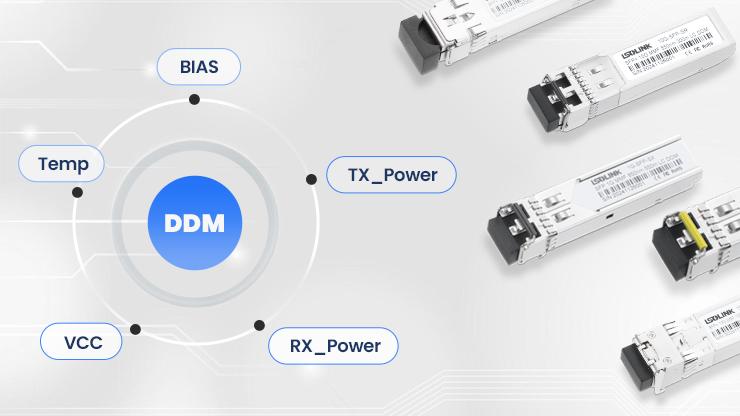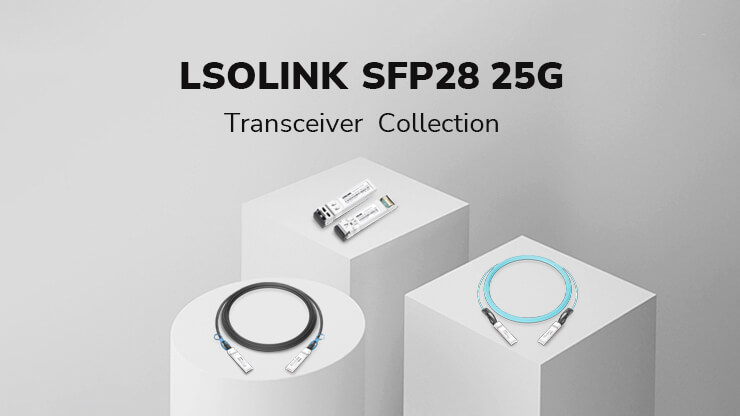LSOLINK SFP28 25G Transceiver Collection: Complete Solutions for Every Connectivity Need
With the rapid rise of emerging technologies such as cloud computing, big data, and artificial intelligence, the scale of data generation and transmission is growing at an astonishing rate. Network speed and stability have become the key factors restricting the implementation of technologies and the development of enterprises. Against this backdrop, the LSOLINK SFP28 product portfolio, with its powerful performance and diverse product line, serves as a reliable solution to complex connectivity needs. Whether it’s data centers with extremely high requirements for transmission rates or enterprise networks that demand stability and reliability, this series provides the right solution. This article will cover product overview, advantages, and application scenarios to give you a comprehensive understanding of the excellence of the LSOLINK SFP28 25G Transceiver.
Overview of the LSOLINK SFP28 Series Products
LSOLINK SFP28 Optical Transceiver
LSOLINK offers a comprehensive SFP28 product portfolio, including optical transceivers and cables. The optical transceiver lineup covers a wide range of models, such as SR, LR, ER, BiDi, WDM, and 10/25G adaptive modules. With its diverse product range, LSOLINK is able to meet the needs of various application scenarios. All LSOLINK optical transceivers are fully compliant with industry standards.

- 25G-SR: Designed for short-distance transmission, it uses OM4 multimode LC duplex fiber and supports transmission distances up to 100m. It is widely deployed for intra–data center connections.
- 25G-LR: The LR transceiver supports transmission distances of up to 10km over OS2 single-mode LC duplex fiber. It is typically used in campus networks or metropolitan area network (MAN) connections.
- 25G-ER: The ER transceiver enables connections of up to 40km over OS2 single-mode fiber, making it suitable for network service providers or large enterprise networks.
- 10/25G Dual-Rate Transceiver: Supporting adaptive 10G rates, this transceiver offers flexibility for network environments undergoing gradual upgrades, ensuring smooth migration from 10G to 25G.
- 25G-BiDi: The BiDi transceiver adopts single-fiber bidirectional transmission technology. Each module must be paired with a corresponding wavelength counterpart (e.g., one side Tx 1270nm/Rx 1310nm, and the other side Tx 1310nm/Rx 1270nm) to enable correct data transmission. LSOLINK 25G BiDi modules support up to 40km transmission distance. With single-fiber bidirectional operation, they effectively save fiber resources, making them an ideal choice for scenarios such as 5G fronthaul.
- 25G-WDM: LSOLINK’ s WDM transceivers provide efficient data transmission and optimal fiber utilization. Available in both CWDM and DWDM types, they support transmission distances of up to 10km, addressing the needs of metro and access network applications.
LSOLINK SFP28 Cable
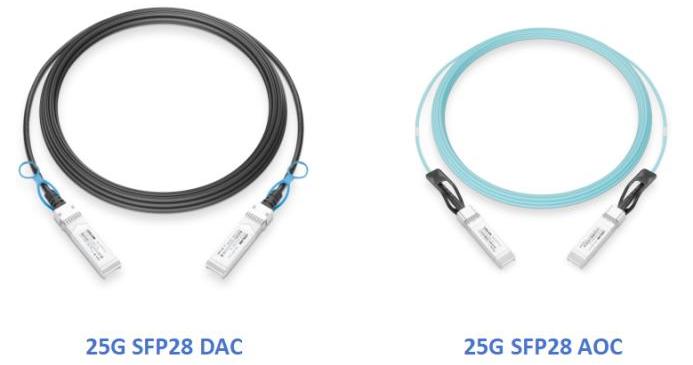
For short-reach connection solutions, LSOLINK also offers a complete range of 25G DAC and AOC products, covering lengths from 0.5m to 100m. These products ensure cost-effective and highly reliable data transmission in short-distance scenarios, commonly used for interconnections between servers and switches, or switch-to-switch links within data centers. With compact and flexible cabling, both copper and optical solutions from LSOLINK are manufactured under strict process and quality control standards to guarantee product reliability and durability.
25G-DAC (Direct Attach Cable)
Designed for low latency and high bandwidth, DAC provides a stable network connection over limited distances at minimal cost, making it an ideal choice for short-reach connections within data center racks.
25G-AOC (Active Optical Cable)
AOC integrates optical modules and fiber into a single assembly. Compared with DAC, it supports longer transmission distances while offering a lower cost than using separate optical transceivers and patch cords. It is particularly well-suited for high-density network environments.
LSOLINK SFP28 Product Main Advantages
- Rich Product Line Suitable for Multiple Scenarios
The LSOLINK SFP28 series products, with a highly segmented product matrix, almost cover all mainstream network application scenarios. In data centers, short-distance transmission requirements can be quickly addressed through 25G-SFP-SR multimode optical modules combined with passive copper cables, meeting high-density interconnection needs within racks. For long-distance transmission across data rooms or metropolitan area networks, single-mode optical modules such as 25G-SFP-LR and 25G-SFP-ER can stably transmit data over distances from 10km to 40km. In scenarios with limited fiber resources, the BiDi series optical modules enable single-fiber bidirectional communication, reducing cabling costs by half. Meanwhile, the CWDM and DWDM series optical modules utilize wavelength division multiplexing (WDM) technology to carry multiple wavelength signals over a single fiber, significantly increasing backbone network transmission capacity. Whether for enterprise office network upgrades, 5G base station backhaul, or cloud data center expansion, users can find precisely matching solutions in the LSOLINK product portfolio. - Real and Comprehensive Equipment Verification
To ensure compatibility with mainstream network equipment, LSOLINK has established a testing system covering leading vendors in the industry. Each SFP28 product undergoes rigorous testing with mainstream switches and server equipment such as Cisco, HPE, Huawei, and Mellanox before leaving the factory. The tests cover more than 20 key indicators, including configuration compatibility, protocol interoperability, and long-term load operation. Through in-depth testing under multiple conditions, LSOLINK products can be quickly integrated into existing network architectures in actual deployments, significantly reducing debugging time and potential risks.
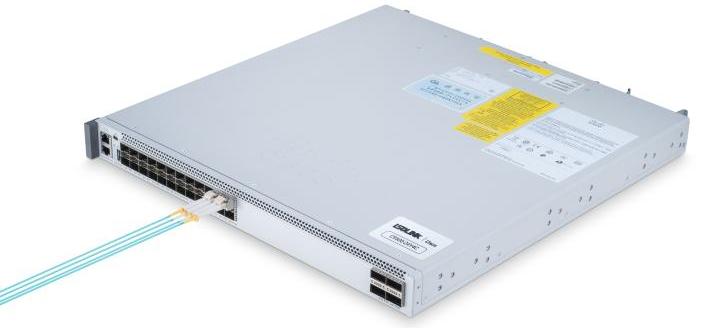
- Excellent Stability
LSOLINK SFP28 products ensure operational stability through multiple technical safeguards. With high-quality optical components and precise manufacturing processes, they guarantee low power consumption, high stability, and excellent signal integrity, maintaining reliable communication even under heavy workloads. In addition, all products are certified under the ISO 9001 Quality Management System. From raw material procurement to final shipment, they undergo 12 stages of quality inspection. LSOLINK provides up to 5 years of warranty service, during which any quality issues under normal use are eligible for free replacement or repair, ensuring uninterrupted network performance for users.
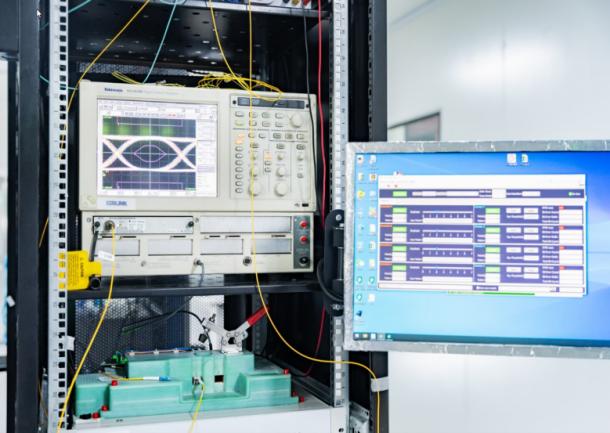
How to Choose the Right LSOLINK SFP28 Product
Selecting the right LSOLINK SFP28 product requires starting from the actual application scenario and comprehensively considering factors such as transmission distance, bandwidth requirements, cost budget, and device compatibility.
Transmission distance is the primary factor. For short-distance connections between devices within data center racks, the 25G-SFP-SR multimode optical transceiver or the 25G-SFP-CU passive copper cable can be the preferred choice, meeting high-speed transmission requirements while maintaining cost advantages. When the transmission distance is within 10km, such as inter-room connections within data centers or inter-building links in enterprise campuses, the 25G-SFP-LR single-mode optical transceiver with single-mode fiber is an ideal option. For long-distance transmission up to 40km, the 25G-SFP-ER ensures stable data delivery, suitable for metropolitan area network (MAN) applications.
Bandwidth demand and network upgrade planning are also crucial. For enterprises currently requiring only 10Gbps but planning to upgrade to 25Gbps in the future, the 10/25G-SFP-SR and 10/25G-SFP-LR dual-rate optical transceivers provide a smooth migration path, avoiding repeated investments. If bandwidth requirements are extremely high and fiber resources are limited, CWDM or DWDM optical transceivers can significantly increase transmission capacity by carrying multiple wavelength signals over a single fiber through wavelength-division multiplexing technology.
Cost and fiber resource availability also impact selection decisions. If fiber resources are abundant, conventional optical modules are sufficient. If fiber resources are limited, BiDi single-fiber bidirectional transceivers such as 25G-SFP-U23-20 and 25G-SFP-D32-40 can save half the fiber resources and reduce cabling costs. In addition, passive copper cables are more cost-effective than active optical cables (AOC) for short-distance transmission. For medium and long-distance transmission, although AOCs have a higher initial cost, their advantages in anti-interference capability and lighter weight make them more cost-effective in the long run.
Device compatibility is another key consideration. All LSOLINK SFP28 products undergo rigorous testing with mainstream networking equipment vendors such as Cisco, HPE, and Huawei. However, before procurement, it is still necessary to provide specific device models to ensure compatibility and avoid potential issues.
Conclusion
In today’s era of surging data traffic and increasingly complex network architectures, the LSOLINK SFP28 25G product portfolio, with its extensive product line, reliable performance, and outstanding compatibility, provides comprehensive solutions to network connectivity challenges across industries. From high-speed interconnections in data centers, to stable backhaul in 5G networks, and to enterprise network upgrades, each product is precisely tailored to specific application scenarios, ensuring efficient and stable data transmission through technological strength.
With a rigorous device validation system and strict quality control, LSOLINK has not only earned users’ trust in product stability but has also set a benchmark for quality in the optical communication industry. Looking ahead, LSOLINK will continue to advance innovation in optical transceiver technology, keep pace with industry trends, and deliver more cutting-edge products and superior services to help global users seize opportunities in the digital era and drive optical communication technology to new heights.
Frequently Asked Questions (FAQ)
Q: Can it be used with 10G SFP+ devices or 25G SFP28 devices?
A: It supports backward compatibility with 10G SFP+ devices (requires the device port to support auto-negotiation), but the rate will be reduced to 10Gbps. When connecting to 25G SFP28 devices, ensure that the rate on both ends is forced to be set to 25GBASE-LR mode to avoid negotiation failure.
Q: How to choose between passive copper cable (DAC) and active optical cable (AOC)?
A: If the transmission distance is within 5 meters and the cost is sensitive, you can choose the 25G-SFP-CU series passive copper cable, which has the advantages of low latency and high cost performance, and is suitable for interconnecting equipment in data center racks; if the transmission distance exceeds 5 meters, or there are high requirements for signal anti-interference and wiring flexibility, it is recommended to use the 25G-SFP-A series active optical cable, which has a transmission distance of up to 100 meters, is lightweight, and has strong electromagnetic compatibility.
Q: Can SFP28 25G support speed reduction to 1G?
A: No, SFP28 modules are usually designed to be compatible with 10G, not 1G.




